20-Hydroxyeicosatetraenoic acid ( 20-HETE)
20-Hydroxyeicosatetraenoic acid (20-HETE) manufactured by forward thinkers Glpbio having Molecular Formula: C20H32O3 and Molecular Weight: 320.5 g/mol , is a remarkable arachidonic acid metabolite, playing a key role in many physiological and pathological activities.It is a quantitative and analytical standard that is guaranteed to meet the MaxSpec identity, purity, stability and concentration specifications. It has a role as a human metabolite and a mouse metabolite. It is functionally related to an icosa-5,8,11,14 tetraenoic acid and an arachidonic acid. This article gives an overview about the role of 20-HETE, specifically in the context of chronic dermatitis (CD) and sensory mechanisms such as irritation and pain. Modern studies have highlighted the processes by which 20-HETE influences TRPV1 activation and its inferences for long term irritation, providing new directions for therapeutic mediation.
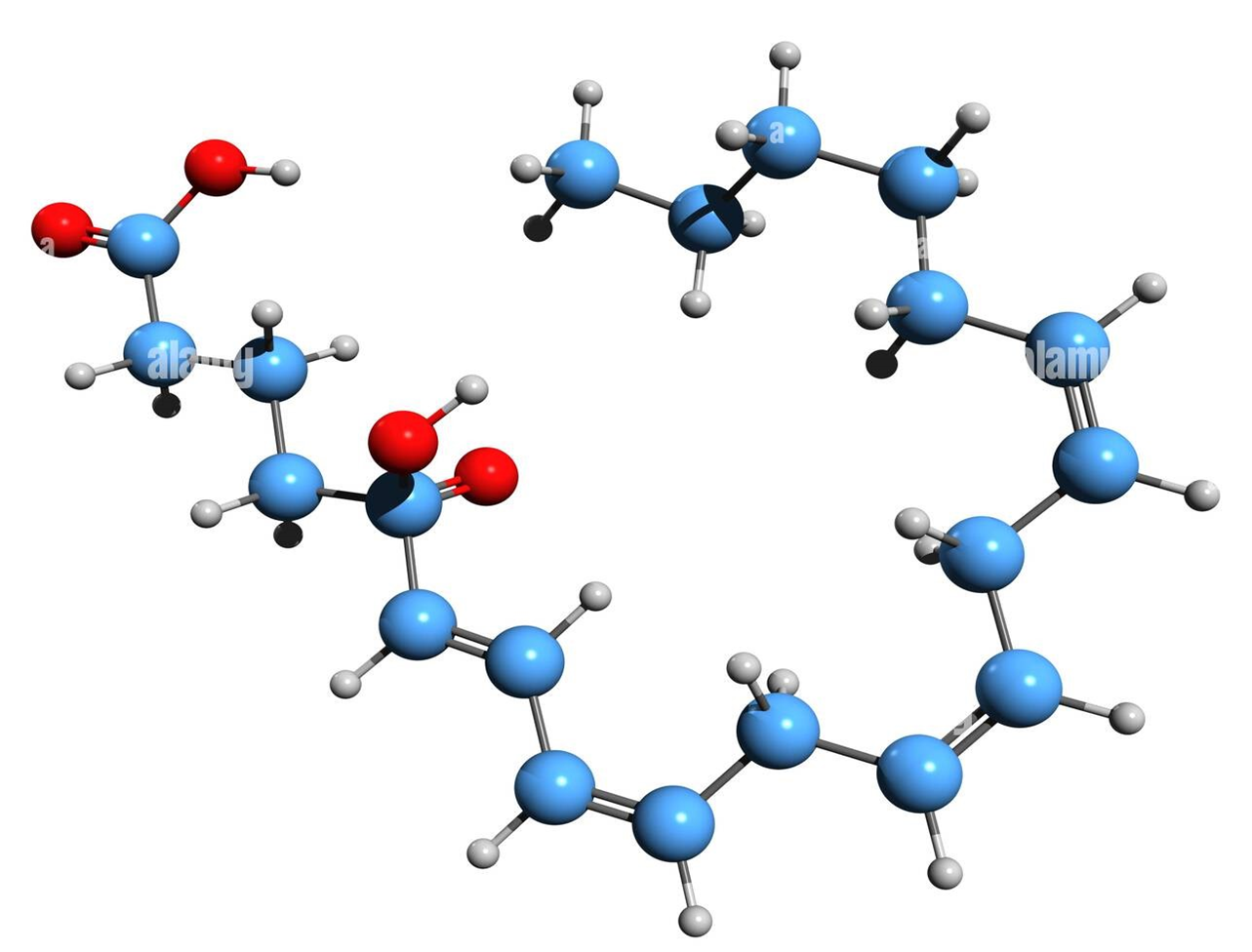
Figure1: This figure shows the 3D structure of 20-HETA (20-HETE 20-Hydroxy Arachidonic Acid 20-Hydroxyeicosatetraenoic acid)
20-HETE in Chronic Dermatitis : Current studies, one of which is described here, have shown that 20-HETE levels are remarkably raised in the mutilated skin of both mice and humans with persistent dermatitis. This elevation is connected to the high level of activation of TRPV1 passages, which in turn propels the heightened irritation response. The research utilised impartial metabolomic studies to recognize the increase in 20-HETE in CD skin, confirming its part as a mediator in this situation.Role of 20-HETE in TRPV1 Activation : Transient Receptor Potential Vanilloid 1 (TRPV1) passages are ion passages that respond to warmth, acidity, and numerous chemical stimulants, which includes capsaicin —the vigorous constituent of chili peppers. These mechanisms are indicated in sensory nerve cells and play a crucial role in discomfort and irritation perceptions. In chronic conditions like dermatitis, TRPV1 passages can become sensitized, causing abnormal sensory responses. 20-HETE functions as an endogenous ligand for TRPV passages. The activation of these passages by 20-HETE in excited MrgprA3+ nerve cells induce alloknesis—a situation where normally harmless prompt causes an irritation response. This research revealed that suppressing the production of 20-HETE with a selective suppression, (HET0016) increased irritation in a mouse version of CD, pointing to its ability as a therapeutic target.
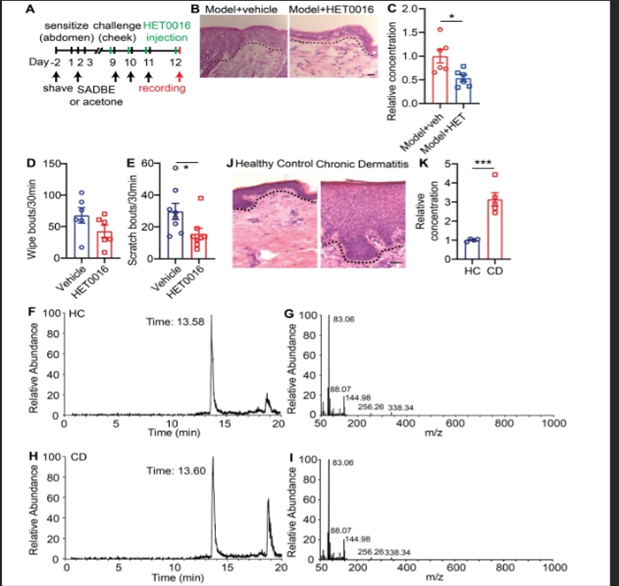
Figure 2. 20-HETE mediated TRPV1 activation drives CD-associated itch. (A) Schematic of the SADBE induced CD model and HET0016 administration. (B) Representative H&E staining of lesional skin from CD model mice treated with vehicle or HET0016. (C) Normalized 20-HETE abundance in lesional skin from CD model mice treated with vehicle or HET0016. (D) Spontaneous wiping in CD model mice treated with vehicle or HET0016. € Spontaneous scratching in CD model mice treated with vehicle or HET0016. (F-I) UHPLC ion chromatograms and MS spectra of 20-HETE in healthy control and lesional CD human skin. (J) Representative H&E staining of healthy control and lesional CD human skin. (K) Normalized 20-HETE abundance in healthy control and lesional CD human skin. *, P < 0.05; ***, P < 0.001. The scale bar represents 50 µm. All data are presented as mean ± SEM
MrgprA3+ Neurons and ERK Phosphorylation : MrgprA3+ nerve cells are a subgroup of sensory nerve cells that have been recognized as important players in mediating irritation. These nerve cells indicate the Mas-related G protein-coupled receptor A3 (MrgprA3) and are operated by a variety of pruritogens. In persistent irritation situations, like dermatitis, these nerve cells can become super sensitive, taking part in the persistent and weakening irritation experienced by sufferers. In the CD conditions, MrgprA3+ nerve cells exhibit increased ERK phosphorylation, an indicator of elevated nerve cell excitability. This intensified response is pivotal for the abnormal irritation reaction identified in CD. This research used multiple models of mouse as well as MrgprA3;Braf mice, to reveal that intensified ERK signalling in MrgprA3+ nerve cells copy the irritation hypersensitivity seen in CD.

Figure 3: shows ERK phosphorylation and MrgprA3+ skin fiber density are enhanced in CD condition. (A) Immunostaining of pERK in TGs from MrgprA3-Cre mice with CD condition (left panel: arrows indicate pERK+ neurons; middle panel: arrows indicate MrgprA3+ neurons; right panel: arrows indicate double positive neurons). (B) Quantification of the proportion of pERK+ neurons in TGs from mice with CD condition. (n = 3). (C) Quantification of pERK positivity in MrgprA3+ TG neurons in mice with CD condition. (D) Immunostaining of MrgprA3-tdTomato in control and lesional skin of CD model mice. The thickness of slice is 50 μm. Above the dotted line is the epidermis. (E) Quantification of MrgprA3+ fiber density in control and lesional skin of CD model mice. The scale bar represents 25 µm. *, P < 0.05; ***, P < 0.001. All data are presented as mean ± SEM
Experimental Findings : The researchers utilised a squaric acid dibutylester (SADBE)-induced CD-like mouse model to analyse the function of 20-HETE in irritation and pain. Habitual trial, calcium imaging, complete-cell patch-clamp recordings, and metabolomic examinations were used to study the processes of the 20-HETE-mediated TRPV1 activation. Human skin biopsies were also examined to corroborate the findings in mice.
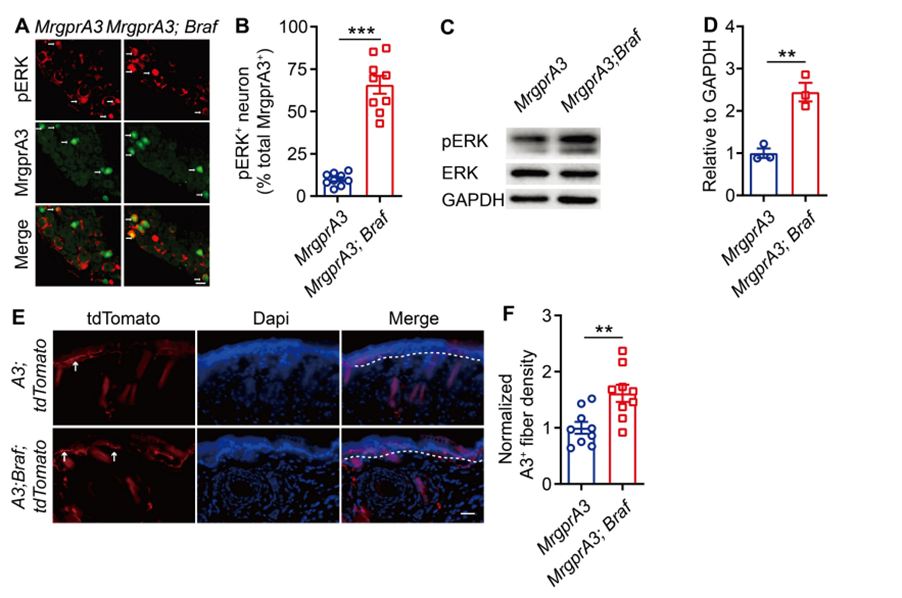
Figure 4. ERK phosphorylation and MrgprA3+ skin fiber density are elevated in MrgprA3;Braf mice. (A) Immunostaining of pERK in TGs from MrgprA3-Cre and MrgprA3;Braf mice (top panel: arrows indicate pERK+ neurons; middle panel: arrows indicate MrgprA3+ neurons; bottom panel: arrows indicate double positive neurons). (B) Quantification of pERK positivity in MrgprA3+ TG neurons from MrgprA3-Cre and MrgprA3;Braf mice. (C) Representative western blot bands showing pERK, total ERK, and GAPDH loading control in TGs from MrgprA3-Cre and MrgprA3;Braf mice. (D) Quantification of western blot bands from the previous panel, showing normalized pERK intensity in TGs of MrgprA3-Cre and MrgprA3;Braf mice. (n = 3). (E) Immunostaining of tdTomato in skin from MrgprA3;tdTomato and MrgprA3;Braf;tdTomato mice. The thickness of slice is 50 μm. Above the dotted line is the epidermis. (F) Quantification of MrgprA3+ fiber density in skin. The scale bars represent 50 µm. **, P < 0.01; ***, P < 0.001. All data are presented as mean ± SEM
Discomfort and Irritation Crosstalk :Discomfort and irritation are well defined yet linked sensory modalities. The conflicting association between these sensations often becomes unclear in pathological situations such as persistent dermatitis. The study's citation emphasises the significance of comprehending the crosstalk between discomfort and irritation passages, specificallyly the part of TRPV1 passages and MrgprA3+ neurons in mediating these perceptions. It is explained that suppressor 20-HETE production with HET0016 adequately decreased irritation habituation in CD-copied mice. This proposed that marking 20-HETE production could be a viable therapeutic plan for controlling persistent irritation in dermatitis sufferers. The decrease in 20-HETE levels also increased skin swallowing, showing wide anti-inflammatory outcomes. Then by targeting TRPV1-MrgprA3+ Neuron Signaling and silencing nerve cells MrgprA3+ using DREADD technology importantly decreased capsaicin-prompted scratching without affecting pain-related behaviors. This careful suppression indicates the ability for selected therapies.
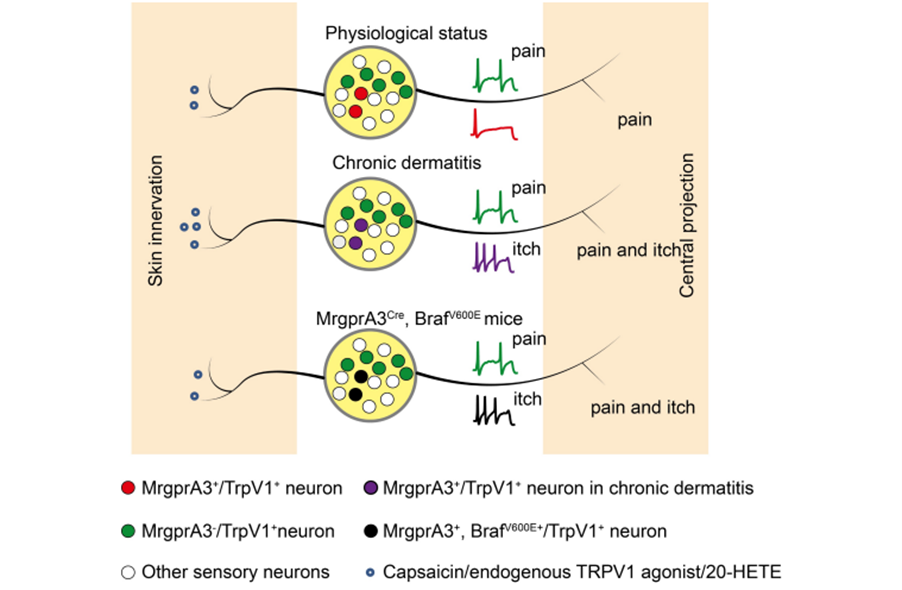
Figure 5. TRPV1 mediated allokinesis in chronic dermatitis requires MrgprA3+ neuron hypersensitivity. Chronic dermatitis enhanced the excitability of MrgprA3+ neurons (purple traces) and increased the abundance of 20-HETE, an endogenous TRPV1 ligand, resulting in allokinesis. Constitutively active Raf, leading to elevated ERK phosphorylation in MrgprA3+ neurons (black traces) mimics CD condition itch hypersensitivity
In short , 20-HETE plays an important part in mediating irritation in persistent dermatitis through energising TRPV1 passages in MrgprA3+ nerve cells. The study's inference provides analytical perception into the molecular processes underlying persistent irritation and focuses on the potential of targeting 20-HETE synthesis and TRPV1-MrgprA3+ neuron signalling as medicinal strategies. As our understanding of these passages goes on to abound, new therapy for persistent irritation and linked sensory situations are more likely to arise, contributing hope for a better standard of life for affected people.





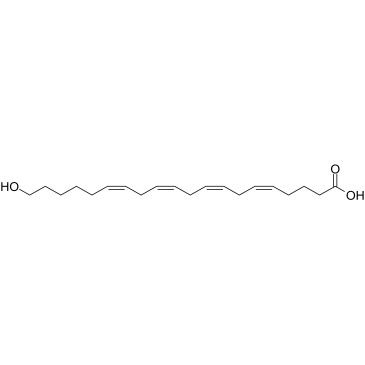









Comments